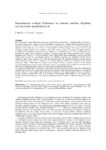Sensorimotor cortical influences on cuneate nucleus rhythmic activity in the anesthetized cat

Ver/Abrir
Use este enlace para citar
http://hdl.handle.net/2183/14594Colecciones
- Investigación (FCS) [1293]
Metadatos
Mostrar el registro completo del ítemTítulo
Sensorimotor cortical influences on cuneate nucleus rhythmic activity in the anesthetized catFecha
1999Cita bibliográfica
Mariño J, Canedo A, Aguilar J. Sensorimotor cortical influences on cuneate nucleus rhythmic activity in the anesthetized cat. Neurosci. 1999;95(3):657-673
Resumen
[Abstract] This work aimed to study whether the sensorimotor cerebral cortex spreads down its rhythmic patterns of activity to the dorsal column nuclei. Extracellular and intracellular recordings were obtained from the cuneate nucleus of chloralose-anesthetized cats. From a total of 140 neurons tested (106 cuneolemniscal), 72 showed spontaneous rhythmic activity within the slow (<1 Hz), δ (1–4 Hz), spindle (5–15 Hz) and higher frequencies, with seven cells having the δ rhythm coupled to slow oscillations. The spindle activity recorded in the cuneate was tightly coupled to the thalamo-cortico-thalamic spindle rhythmicity. Bilateral or contralateral removal of the frontoparietal cortex abolished the cuneate slow and spindle oscillations. Oscillatory paroxysmal activity generated by fast electrical stimulation (50–100 Hz/1–2 s) of the sensorimotor cortex induced burst firing synchronized with the paroxysmal cortical “spike” on all the non-lemniscal neurons, and inhibitory responses also coincident with the cortical paroxysmal “spike” in the majority (71%) of the cuneolemniscal cells. The remaining lemniscal-projecting neurons showed bursting activity (11%) or sequences of excitation–inhibition (18%) also time-locked to the cortical paroxysmal “spike”. Additionally, the cerebral cortex induced coherent oscillatory activity between thalamic ventroposterolateral and cuneate neurons. Electrolytic lesion of the pyramidal tract abolished the cortically induced effects on the contralateral cuneate nucleus, as well as on the ipsilateral medial lemniscus.
The results demonstrate that the sensorimotor cortex imposes its rhythmic patterns on the cuneate nucleus through the pyramidal tract, and that the corticocuneate network can generate normal and abnormal patterns of synchronized activity, such as δ waves, spindles and spike-and-wave complexes. The cuneate neurons, however, are able to generate oscillatory activity above 1 Hz in the absence of cortical input, which implies that the cerebral cortex probably imposes its rhythmicity on the cuneate by matching the intrinsic preferred oscillatory frequency of cuneate neurons.
Palabras clave
Sensiromotor cortex
Cuneate nucleus
Synchronized activity
Cat
Cuneate nucleus
Synchronized activity
Cat
Versión del editor
Derechos
Creative Commons Licence Reconocimiento-NoComercial-SinObraDerivada 4.0 Internacional






